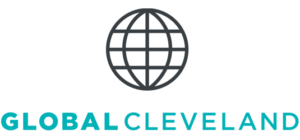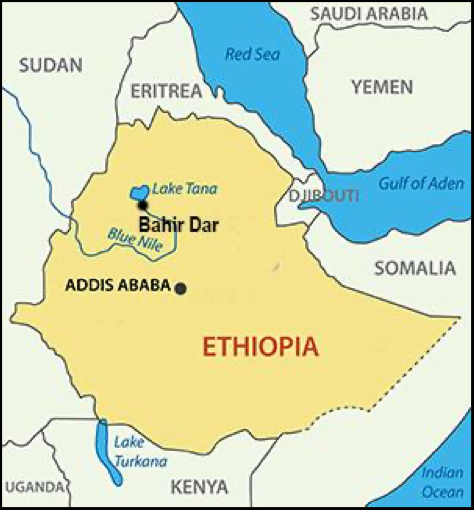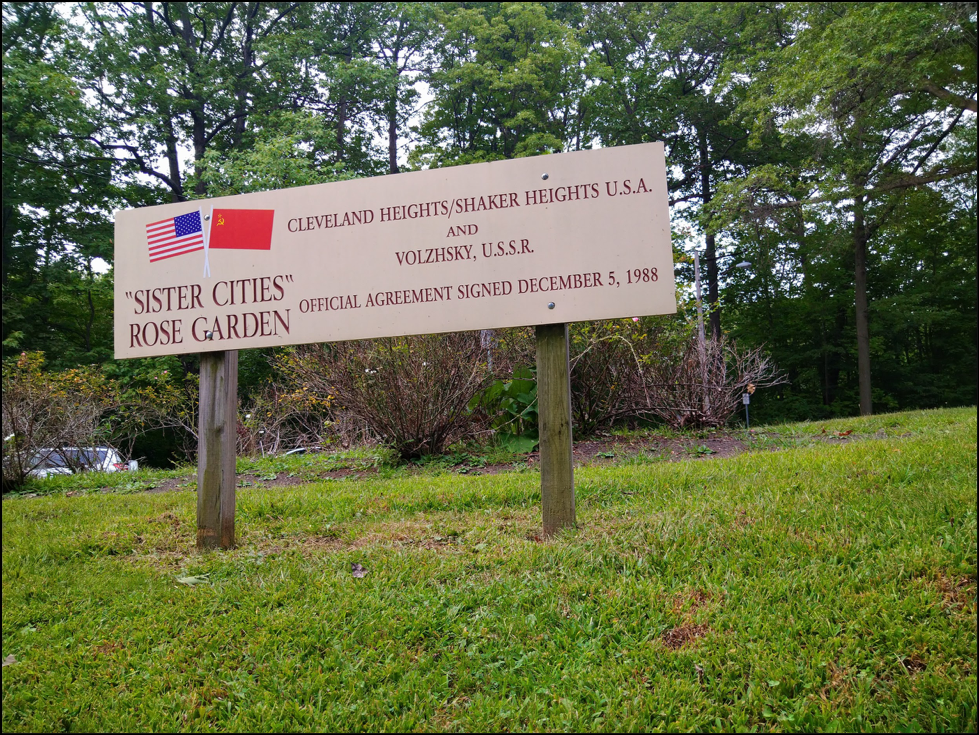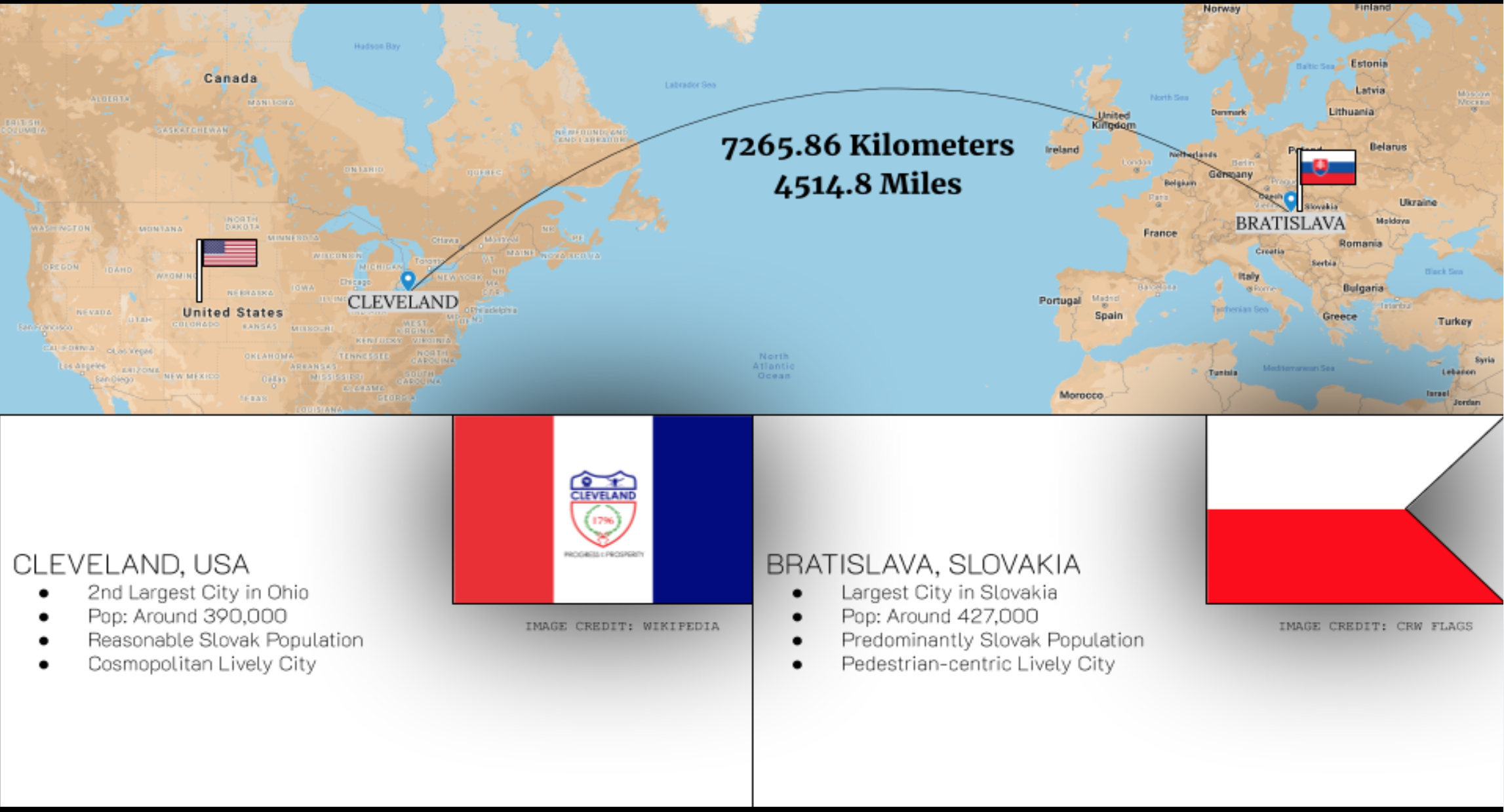Taipei and Cleveland - By Ezra Ellenbogen
Taipei and Cleveland
- Written By Ezra Ellenbogen
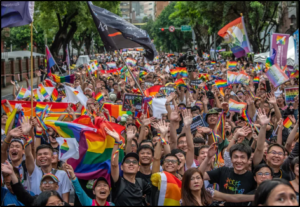
An image of a Pride event in Taipei
Image Credit to Carl Court / Getty Images
June is Pride Month in the United States! In the United States, LGBTQ+ rights have come a long way since the original Stonewall riots (though there is still some progress to be made), but globally, LGBTQ+ citizens are most often not given the same rights as straight citizens, and even sometimes considered illegal. Unfortunately, Asia is home to little progress in this field, but Taiwan has pioneered LGBTQ+ rights in a region where such rights are almost unheard of.[1]Taiwan’s capital is Taipei - and the city of Taipei is a sister city of Cleveland. First - a bit of background.
On September 25th, 1975, former Cleveland Mayor Ralph J. Perk and former Taipei Mayor Lin Yang-Kang partnered their cities as sister cities.[2] Taipei City is a very friendly city, as shown with their total of 52 sister city partnerships (Cleveland has 23 including Beit-She’an).[3] In 1985, Taipei City generously gifted the Chinese Cultural Garden to Cleveland.[4] The beautiful garden was modeled after the Chinese Imperial Palace and includes two Chinese dragon statues as well as one of Confucius. In 1990, the state of Ohio and Taiwan became “sister states.[5]” Ties between the two regions have been positive throughout the sister city relationship.
In 2016, Taiwan was the 6th largest export market in Asia for Ohio. Business interactions between Taiwanese businesses and the city of Cleveland have helped diversify the reach of numerous Taiwanese products. Moreover, Taiwanese students have had numerous scholarly opportunities in Cleveland, especially with Case Western Reserve University. Reciprocally, Cleveland students have had similar academic opportunities in Taiwan, and both sides of the exchange have helped spread Taiwanese and Cleveland culture.[6] For instance, in May 2019, 16 Taiwanese high-school-age music students visited the city of Cleveland, welcomed by a local delegation that later traveled to meet the same group in Taiwan. While visiting Cleveland, the students toured three world-renowned music conservatories across Northeast Ohio, learned about music therapy, and more. In Taipei in October, Cleveland’s delegation of 3 high-school students participated in local music-themed activities and music service learning projects, visited local temples, learned about playing the Chinese Zither (Guzheng), and more.
Taiwan is known for its progressiveness with LGBTQ+ rights, as well as its festive Pride celebrations. The country’s rights for members of the LGBTQ+ community are still developing, but they are certainly the most forward in the region. Taiwan has a large and flourishing LGBTQ+ community, and a record 200,000 people participated in Taipei’s 2019 Pride parade.[7] For comparison, 80,000 people attended the 2015 Taipei Pride event.[8] The main reason for the sudden influx of pride and celebration was that Taiwan legalized same-sex marraige that year. The struggle for LGBTQ+ rights in Taiwan has been a long and politically divisive one.[9] Taipei’s Pride march started in 2003, and since then, there has been a major political movement behind legalizing same-sex marraige in the country.
In 2016, the first female president of Taiwan, Tsai Ing-wen, was elected, and expressed clear support for the LGBTQ+ community as well as its members’ legal rights. In 2017, the Taiwanese constitutional court struck down the Civil Code’s definition of marriage being only between a man and a woman, and this led to a political struggle throughout Taiwan’s government that resulted in the 2019 legalization of same-sex marraige by President Tsai.
Taiwan is well-known globally for its modern Pride celebrations. In fact, Taiwan’s Pride parades most often include international groups. Taiwan is a beacon for LGBTQ+ rights in Asia, and the country’s Pride celebrations include Pride movements from other countries that are not supported by their own state, including prominent Hong Kong LGBTQ+ movements.[10]
Pride celebrations in Taiwan typically occur in the month of October, which is known as LGBTQ+ History Month, or sometimes Queer History Month. In the United States, Pride celebrations are typically in June, to commemorate the Stonewall riots. October was chosen for other countries’ Pride months to coincide with Coming Out Day - which is October 11th.[11]
Taipei City and Cleveland have a history of cooperation and beneficial cultural exchange. Moreover, now is a good time to recognize and appreciate the progress made by Taiwan, not only for its cultural diplomacy with the United States and especially Cleveland, but also for its wondrous progress with LGBTQ+ rights. It is important to recognize the progress that has been made globally, as well as what still needs to be accomplished.
Happy Pride Month!
[1] https://www.ozy.com/news-and-politics/special-briefing-is-asia-becoming-gay-friendly/94470/
[2] https://english.sec.gov.taipei/cp.aspx?n=2789B64DFDD8B838
[3] http://www.tcc.gov.tw/en/cp.aspx?n=81569D74DD82C7DB
[4] https://case.edu/ech/articles/c/cleveland-cultural-gardens
[5] https://english.moe.gov.tw/fp-117-22292-DAE02-1.html
[6] https://www.ccwa.org/building-bridges-from-cleveland-to-taiwan/
[7] https://focustaiwan.tw/society/201910260006
[8] https://oftaiwan.org/social-movements/lgbtq-movement-in-taiwan/
[9] https://www.nytimes.com/2017/05/24/world/asia/taiwan-same-sex-marriage-court.html?mwrsm=Facebook&_r=0
[10] https://www.nbcnews.com/feature/nbc-out/taiwan-pride-bigger-ever-beacon-lgbtq-rights-asia-n815641
[11] https://www.wright.edu/diversity-and-inclusion/culture-and-identity-centers/lgbtqa-affairs/international-lgbtqa-dates-to-know
Braşov and Cleveland - By Ezra Ellenbogen
Braşov and Cleveland
- Written by Ezra Ellenbogen
 Braşov [Hungarian: Brassó], Romania is a beautiful city tucked into a Southern region of the Carpathian mountains known as the Transylvanian Alps. The city has a rich history and culture located on the edge of southeastern Transylvania, along one of the most historically important trade routes in Romania’s history.[1] It is the capital of the Braşov judet in Romania, and has a population of over 275,000.[2] Braşov was twinned with Cleveland in 1973 as Cleveland’s second ever sister city.[3] The charming multicultural city was founded in the 13th century at the center of trade between the Ottomans and Europe.[4]
Braşov [Hungarian: Brassó], Romania is a beautiful city tucked into a Southern region of the Carpathian mountains known as the Transylvanian Alps. The city has a rich history and culture located on the edge of southeastern Transylvania, along one of the most historically important trade routes in Romania’s history.[1] It is the capital of the Braşov judet in Romania, and has a population of over 275,000.[2] Braşov was twinned with Cleveland in 1973 as Cleveland’s second ever sister city.[3] The charming multicultural city was founded in the 13th century at the center of trade between the Ottomans and Europe.[4]
The city thrived as a result of extensive trade with European merchants and other Romanian cities. However, a few hundred years after being founded, Braşov was captured and temporarily occupied by Turkish forces (1421). The city soon surrounded itself with strong walls to deter invaders - which worked. In 1432, when forces attempted a second invasion of the city, Braşov was able to hold them off. Although these walls were built for the purpose of geopolitical safety, they soon became part of the reason the city flourished.
The sheltered Transylvanian city soon became an influential and multicultural center of Romania, economically and culturally. German mercantile groups became prominent in the city, and European merchants and workers (as well as the original Dacian settlers) soon built up the city. Braşov became a center of trade between the three distinctly separated regions of Romania, and drove the country forward.
A few hundred years later in the late 1800s, Romanians began to settle in Cleveland, many driven away from their home country. Cleveland’s new Romanian population was primarily from Transylvania - which was then under the rule of Austria-Hungary. By the outbreak of the First World War, Romanians numbered 12,000 in Cleveland.[5] The main concentration of Romanian International Newcomers was around Detroit Avenue on the West Side, between W. 45th and W. 65th Streets. These areas of Cleveland were already known for Irish and German International Newcomer populations, and the introduction of Romanians further diversified the iconic area. Collinwood, Bedford, and Lakewood had their own Romanian populations as well. Lorain accumulated a Romanian population too, and contact between Romanian populations in all of these areas was always kept strong. Many Romanian communities across the area were not self-sufficient enough to thrive, and most Romanians ended up consolidating into a population on the West Side. By World War Two, most of the Romanian population had followed the general Migration towards the West Side. Moreover, many Romanian International Newcomers did not end up initially settling in rural areas because it was hard to quickly find capital to start a farm - though Romanian International Newcomers who enjoyed the rural life were soon able to find themselves in farms again not too long after immigrating.
The original intent of much of Romanian Migration was not permanent residence in the city, though by the end of the First World War, many Romanians found that Cleveland suited them. During the years of the Post-War Period, around half of Cleveland’s Romanian population returned home, leaving Cleveland’s Romanian population at 6,000. Many of these Romanians were incentivized to return home by the news that Transylvania and Bucovina had become part of Greater Romania. There was also a movement of Romanians who settled in Cleveland, as well as some who went back to Romania to find a family, then went back to America with them. The American Migration restrictions introduced in the early 1920s slowed down most Migration patterns. By 1940, the population of Romanians in Cleveland numbered only 4,000.
The political outcome of World War Two in Romania was displeasing to numerous groups of Romanians, many of whom ended up immigrating to America as a result. After World War Two, a Communist regime had been put into place at the head of Romanian society, which drove 2,000 Romanians into Cleveland alone (not only from Transylvania, but from all over the country). The West Side area that was formerly a Romanian hotspot began to break apart with new waves of Migration from numerous areas, and many newer generations in the area moved out west to suburban regions. New Romanian waves of Migration continued the legacy of the area, but it is now much more diverse, with a wide range of International Newcomer populations.
As a result of all these periods of Romanian Migration, Greater Cleveland is now not only home to about 20,000 Romanians,[6] but also numerous Romanian-American national societies and organizations, like the Carpatina Society.[7]Moreover, Cleveland’s historic relationship with Romania led former Romanian President Nicolae Ceaușescu to visit the city in 1973 and encourage extensive trade between Romania and Cleveland companies.[8] Efforts between Romania and Cleveland to incentivize trade and cultural relations have been strong throughout history. A host of Romanian politicians have visited Cleveland, from former Braşov mayor, Dumitrache, to Minister Draganescu.[9] Further, Romanians loved “The Singing Angels” on the band’s visit to the country in 1974, and Clevelanders got to welcome Nadia Comaneci, the first gymnast to get a perfect score of 10.0 at the Olympic Games.[10]
Cleveland and Romania, even through numerous political troubles and disputes, have been global partners culturally and economically. The influence of Romanian Migration to Greater Cleveland can still proudly be seen today. The Cleveland-Braşov sister city relationship has emphasized the current and historical success of Romanian-American endeavors and cooperation.
[1] https://www.balkantrails.com/brasov-rich-history-in-the-heart-of-romania/
[2] https://worldpopulationreview.com/countries/romania-population/cities/
[3] https://case.edu/ech/articles/cleveland-sister-city-partnerships
[4] https://www.gpsmycity.com/blog/brasov-the-heart-of-romania-2404.html
[5] https://case.edu/ech/articles/r/romanians
[6] https://www.cleveland.com/metro/2016/08/three-day_romanian_festival_on.html
[7] https://ohiohistorycentral.org/w/Carpatina_Society
[8] https://www.nytimes.com/1973/12/08/archives/ceausescu-urges-us-business-to-invest-in-rumania-president-cites.html
[9] https://books.google.com/books?id=fjgtAAAAMAAJ&pg=PA290&lpg=PA290&dq=Brasov+and+Cleveland&source=bl&ots=xDsY7JFybu&sig=ACfU3U0A9hrUAthChP9tNiVg0zZ49lBwQQ&hl=en&sa=X&ved=2ahUKEwjTxa_E3qnpAhWGZM0KHeW5C-QQ6AEwCXoECAoQAQ#v=onepage&q=Brasov%20and%20Cleveland&f=false
[10] https://books.google.com/books?id=B8DUAAAAMAAJ&pg=PA446&lpg=PA446&dq=Bra%C5%9Fov+Cleveland&source=bl&ots=yhOhcjqXQM&sig=ACfU3U3ev91muW23z4I-og1oBZZyDQFPEA&hl=en&sa=X&ved=2ahUKEwiqksjDwbvpAhWFHc0KHVngApUQ6AEwCHoECAoQAQ#v=onepage&q=Bra%C5%9Fov%20Cleveland&f=false
Cleveland and County Mayo: A New “Angle” on Cleveland - Ezra Ellenbogen
Cleveland and County Mayo: A New “Angle” on Cleveland
- Written by Ezra Ellenbogen
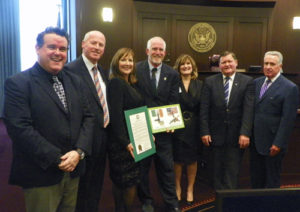
County Mayo, located along parts of the northwestern coast of Ireland with a population of around 130,000, has been twinned with the city of Cleveland since 2003.[1] This sister city relationship was a result of uniquely Irish Migration patterns as well as community bonds that led to Cleveland’s rise as an Irish home. From traditional culture and westward Migration to the “Angle” community, the story of Irish relations with Cleveland is a detailed and interesting one.
Between 1820 and 1825, the first Irish International Newcomers arrived in Cleveland. Even from the start, most of the Irish International Newcomers in Cleveland hailed from County Mayo.[2] In 1825, the construction of the Ohio and Erie Canal began, and workers were needed. This coincided with the increased Migration of Europeans from poorer areas, including the Irish, who numbered around 500 by 1826.[3] Many of the Irish workers who flocked to Cleveland for the jobs the canal project provided originally meant to stay temporarily, but the 1827 extension of the project resulted in the dense settlement of the Irish around the so-called “Irishtown Bend.” With the start of the Industrial Age and the numerous jobs it brought along with it in Cleveland, Migration flourished, especially Irish Migration. Even though Irish Migration to Cleveland was mostly from the County Mayo region, an agrarian area, Irish International Newcomers in Cleveland were hard workers during the Industrial Age and contributed greatly to Cleveland's Industrial economic boom.
Irish Clevelanders reached more significant numbers by the late 1840s. As a result of Potato Famine Migration (the patterns of mass eMigration from Ireland to the United States because of Irish potato famines), Irish Clevelanders numbered over 1,000 by 1848. The Civil War’s need for transportation of people and cargo brought even more jobs to Cleveland and worked with the Industrial Age to invigorate further Irish Migration. Irish Migration to the city only grew more rapidly from there. By 1870, the Irish population grew to be over 10,000, or 10% of the city’s population at the time. In 22 years (1848-1870), the Irish population in the city went up almost tenfold. During the 1860s and 1880s, horrible weather in County Mayo (particularly Achill Island) drove even more Irish people to emigrate. Although Irish Migration kept a relatively rapid pace, it did not keep up with Cleveland’s overall boom as a city. By 1900, the 13,000-some Irish represented only 3.5% of the city’s population.
Irish International Newcomers in Cleveland tended to cluster in densely populated areas, often earning those parts of the city unique names. Not only was there the ‘Irishtown Bend,” where canal workers settled, but there were many other areas, each with their own nickname. The area west of the river by the lake in Cleveland earned itself the name the “Achill Patch,” in honor of Achill Island in County Mayo, the original home of many of the Irish settlers. Most famously, there was “The Angle,” or “The Triangle.” This area, defined by its large Irish population and St. Malachi Parish, has been broken up by geographic changes but remains a strong community. It was, at its peak, the most famous Irish area of Cleveland.[4] It is interesting to note that most of these areas were close to each other, and by some definitions, overlapped.
The Angle was defined as the roughly triangular area between West 28th Street, Division Avenue, and River Road[5], across from Whisky Island (hence the name, “The Triangle”). It mainly consisted of Irish houses and shops. The cultural center of the neighborhood was St. Malachi Parish, which was founded in 1867. However, the whole West 25th Street area, from 1860 and onwards, was known as a very Irish area. At one point, St. Malachi Parish listed 2,000 Irish families in the region. The Angle only grew, and soon came to include most of the area north of Detroit Avenue that sloped down to the well-known angled riverbed. In 1917, the Detroit-Superior Bridge project started to geographically break up the Irish community in the region. Later, the Lakeview Terrace Housing Project and other bridges (including part of the Cleveland Memorial Shoreway) struck a geographic barrier between parts of the Irish region. Though the area remains an Irish neighborhood, many of the inhabitants of the old Angle left for other areas. However, St. Malachi Parish’s Sunday services still attract many from the old community.
An 1881 Map of Cleveland With “The Angle” Marked, Image Credit to the Irish American Archives Society
When they arrived in Cleveland, many Irish International Newcomers flocked to the police force and politics. The prejudice expressed at the time by many Americans was the idea that Irish International Newcomers were all supposedly criminals. Ironically, Irish International Newcomers were more often police officers than most else. In 1874, Cleveland’s Irish population made up 10% of the city’s total population and 20% of the city’s police population. In 1902, it was 3.5% and 12.5% respectively. Later, as Irish International Newcomers assimilated more into Cleveland, the proportionately large percentage of them on the force shrank. The Irish population of Cleveland grew to influence many aspects of the city and its culture.
In 2003, under Mayor Jane Campbell, Cleveland partnered as a sister city with County Mayo. This was a celebration of the ancestral lineage of most Irish Clevelanders from that region as well as the creation of numerous new business and social opportunities between Irish and Cleveland communities. Stephen Mulloy spearheaded the effort with years of planning.[6] In July 2003, a Cleveland delegation of Mayor Campbell, Stephen Mulloy, and prominent Irish Clevelanders visited County Mayo. Later in the same year, the Chairman of the Mayo County Council and other delegates visited Cleveland. During that October event, delegates from both areas celebrated Irish heritage in the city with numerous newspapers, notes, documents, and other artifacts from Irish International Newcomers in the region.
This relationship went on to inspire many others. For instance, the Mayo Society of Greater Cleveland and Údarás na Gaeltachta (Gaeltacht Authority) have become business partners as a result of the connection between the two areas.[7]In fact, in 2018, the Mayo Ball saw the arrival of people and businesses from County Mayo and nearby Irish counties, and three Irish companies presented their products and companies to Clevelanders and businesses alike. Delegates and political representatives from County Mayo attended the event, alongside representatives from Cleveland Irish American groups.
At the same event, many who attended worked together to form plans for International Mayo Day, an annual international celebration of all things County Mayo. The event started in 2015 and has been held yearly since in Western Ireland. There, international spectators and locals alike celebrate everything about County Mayo culture, from literature to business. Moreover, the holiday has extended into the US, the UK, and beyond as local County Mayo populations celebrate their heritage.[8] This is all thanks to Martina Hughes of Mayo county council, who had thought of the idea originally. If you’d ever like to help celebrate Cleveland’s County Mayo heritage, May 4th is International Mayo Day.
County Mayo is truly a wondrous land, with astounding coasts and stunning culture. They’re known for their diaspora and International Newcomer populations in other areas. In fact, while County Mayo numbers around 130,000 people, the diaspora of the county is over 3.5 million strong. Cleveland is more than proud to work with County Mayo and celebrate the contributions of Irish International Newcomers to the city. Without Irish Migration, from the Achill Patch to the Angle, Cleveland would not be where it is today.
- By Ezra Ellenbogen
Ezra's blog: One Page Stories
[1] https://case.edu/ech/articles/cleveland-sister-city-partnerships
[2] https://case.edu/ech/articles/i/irish
[3] http://www.irisharchives.org/pdf/IrishAndAngle.pdf
[4] http://www.clevelandmemory.org/iac/articles/Irangle.html
[5] Some sources defined it by the riverbed instead of a third road
[6] http://ead.ohiolink.edu/xtf-ead/view?docId=ead/OCLWHi0286.xml;query=;brand=default
[7] https://ohioirishamericannews.com/2018/11/04/the-green-and-red-ball-mayo-celebrates-again/
[8] https://www.irishtimes.com/special-reports/mayo-day/mayo-day-is-a-celebration-of-mayo-ness-worldwide-and-has-grown-over-last-5-years-1.3864953
A History of Slovenians in Cleveland
A History of Slovenians in Cleveland
- By Ezra Ellenbogen
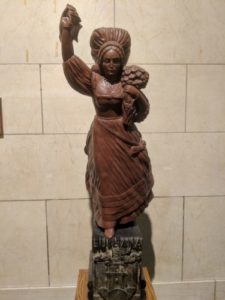
Ljubljana [lyoo-BLYAH-nuh], Slovenia is a city of over 270,000 twinned with Cleveland in 1975.[1][2] It is the centrally-located capital and largest city of Slovenia and has a very cosmopolitan culture, hosting over ten thousand cultural events annually.[3] Cleveland’s sister city partnership with Ljubljana was developed to recognize Cleveland’s historic Slovenian population. Cleveland has always been a city with a significantly high Slovene population - the city had the largest Slovene settlement group in the US for approximately ninety years[4], and is now the city with the largest Slovene population outside of Slovenia.[5] Slovenian development in Cleveland followed interesting patterns unique to their ethnic group.
Between the 1880s and the start of World War I, Slovenia experienced a significantly large pattern of Migration, particularly into the United States. Coveting newly created mining jobs in the United States, many Slovenians immigrated, especially to the areas of Georgia (in the 1730s), Michigan (Calumet), Wisconsin, Minnesota (Brockway), Illinois (Joliet), Iowa, Nebraska (Omaha), and Ohio (Cleveland).[6] However, Slovenians feared the American prejudice against Slavic (and especially Slovenian) people at that time. Thus, upon Migration, many said they were Austrian or Slavonic. Slovenian International Newcomers tended to quickly assimilate into new workplaces while maintaining strong cultural ties through their establishment of Slovenian settlements.
The most pronounced periods of Slovenian Migration into Cleveland were between 1890-1914, 1919-24, and 1949-60. Mass Migration from Slovenia was at first prominent before the start of World War I and eventually resurfaced following World War II and political troubles in Slovenia. However, the two distinct Migration groups (pre-WWI and post-WWII) were demographically dissimilar. Most International Newcomers who came before the start of World War I were of an economically underdeveloped and rural demographic. International Newcomers to the US following World War II were mainly political Displaced Personss, hence a larger proportion were professionals and well-educated. The Slovenian community of Cleveland was drastically changed post World War II, with the introduction of not only higher educated Slovenians, but also of emigres from other Slovenian settlements in the US. Cleveland became principally attractive to the 2nd-generation-Slovenian-emigres because of the rapid expansion of its industrial sector, which called for large amounts of unskilled and semiskilled labor that Cleveland did not have. Moreover, at that time, the demographics of the American job market gave Slovenians an advantage, because the labor base was predominantly German, and many Slovenians knew German, especially those who emigrated pre-WWI. From the early 1900s until the late 1990s, Cleveland had the largest Slovene settlement group in the United States.
The Newburgh area (near the south side of Cleveland) was the epicentre of the initial Slovenian Migration, followed by the area around St. Clair Avenue. Collinwood soon became established as a Slovenian settlement, expanding into Euclid. After the 1980s, cities in Lake County became points of interest for Slovenian Migration, and eventually so did Garfield Heights and Maple Heights. Interestingly enough, no successfully independent Slovenian settlements emerged in the West Side of Cleveland. Indicators at the time showed that Cleveland Slovenians, even as they acquired US Citizenship, were not giving up their heritage and certainly not culturally assimilating. This was unlike other groups that either entirely assimilated or remained entirely separated.
A rift of ideology grew among Slovene Clevelanders. This was strongly reflected in the liberal Slovene-language newspaper Enakopravnost’s conflict with Slovenian conservative religious groups in the city. By 1914, Slovenian Clevelanders were mostly split between conservative Catholics and “freethinking” liberals (many of whom identified as socialists). There were no major conflicts as a result of the ideological divide. However, a roadblock in the process of Slovenian Migration to Cleveland came with the start of World War I.
During that time, Slovenians in Cleveland flourished culturally and somewhat economically, despite a lack of new International Newcomers. Once the First World War ended, Slovenian Migration to the city gradually increased, and many professionals and higher-educated groups became prominent parts of Slovenian-American society. This led to the growth of successful careers for many Slovenian-Americans, including Frank John Lausche, a prominent Eastern European politician who later served as the first Eastern European mayor of Cleveland.[7]
The rise of World War II in Europe complicated the ideological divide in Cleveland. Slovenia, a part of Yugoslavia at the time, was split between rival resistance groups, and thus, Slovenian Clevelanders grew increasingly split based on their political opinions (pro-Communist/pro-Titoist against anti-Communist/pro-Religious-Conservativism). But World War II also saw a new period of Slovenian Migration to America, with thousands of new Slovenians coming to the US, especially Cleveland. The post-WWII emigres were typically better educated and viewed with politically-based suspicion from the more progressive wing of Slovenian Americans. Despite the growth of the ideological divide, post-WWII Migration reinvigorated Cleveland’s Slovenian cultural scene. Moreover, the ideological divide never led to any major conflict between Slovenian Clevelanders.
In 1975, former Cleveland Mayor Ralph Perk forged a sister city relationship with the capital of Slovenia as an acknowledgement of the long history of Slovenians in Cleveland. In fact, Perk reported that, among the many sister cities he partnered with, he was most proud of his efforts to associate Cleveland with Ljubljana. By the 1990s, the Slovenian population in Cleveland numbered well over 50,000, many of whom were still connected to their homeland culturally and linguistically. Although the city no longer has the largest individual Slovene-American settlement group, the number of Slovenians in the city has now surpassed 80,000, making Cleveland home to the largest Slovene population outside of Slovenia.[8]
Cleveland’s connection to Ljubljana is stronger now than ever, especially after a friendly 2011 meeting between Jurcek Zmauc, the consulate general of the Republic of Slovenia in Cleveland, and Mayor Frank Jackson.[9] Zmauc is well-aware of the connection between Slovenians and Cleveland, having said that “There is no village in Slovenia that does not have relatives in Cleveland.” The former mayor of Cleveland’s sister city, Vicenza, Achille Variati, also attended. Cleveland has worked diligently to form initiatives in the Eastern European region to lure new talent to the area, and to cooperate effectively with our many sister cities.
Cleveland’s history with Slovenia is a long and interesting one, reflecting the unique nature of Slovenian International Newcomers in the region. Many call Cleveland a Slovenian city, for the city reflects not only the cultural and historic values of Slovenian-Americans, but also mirrors the culturally cosmopolitan nature of Ljubljana itself. Although Slovenians in Cleveland have had historical ideological divisions and disputes, the community is still incredibly strong and interconnected. Our relationship with Ljubljana is one of the most important and historic sister city relationships Cleveland has ever forged, and the city looks forward to an enduring continuation of this historic bond.
- By Ezra Ellenbogen
Ezra's blog: One Page Stories
[1] https://www.worldometers.info/world-population/slovenia-population/
[2] https://case.edu/ech/articles/cleveland-sister-city-partnerships
[3] https://www.timeshighereducation.com/student/where-to-study/study-in-slovenia
[4] https://case.edu/ech/articles/s/slovenes
[5] https://clevelandhistorical.org/items/show/289
[6] https://www.everyculture.com/multi/Pa-Sp/Slovenian-Americans.html
[7] https://case.edu/ech/articles/l/lausche-frank-john
[8] https://toursofcleveland.com/cleveland-city-hall-sister-city-ljubljana/
[9] https://www.cleveland.com/metro/2011/04/cleveland_to_seek_new_ties_wit.html
The Two Clevelands
The Cleveland Hills in England, Image Credit: Northyorkmoors.org.uk
The Two Clevelands
-By Ezra Ellenbogen
Cleveland is a city in Ohio in the United States, but Cleveland is a region in Britain that was formerly a county. It’s easy to get the two confused. You’ve probably encountered this phenomenon before - two towns with the exact same name! Whether it be Toledo, Ohio and Toledo, Spain or Newcastle, Australia and Newcastle, Britain, there are many towns and cities whose names are the exact same. Two of these name-twins are Cleveland in the US and Cleveland in the UK. It is no wonder that they’ve been paired as sister cities since 1977![1]
As you know, the sun did eventually set on the British Empire, but many names of theirs have stuck around - a lot of them. In fact, BBC America estimated that 650 cities in the US have an English town as their namesake.[2] Another interesting fact about this phenomenon: Richmond is the British place name most copied internationally.[3] And if you haven’t heard of these twin-named-cities, take out a map and take a gander at such cities as London, Ohio, Birmingham, Alabama, and even Boston, Massachusetts. But the story of the two Clevelands is not just another tale of an American city named after an English city.
To mention, there is a common falsehood that Cleveland in England and in Ohio have two separate etymological origins. As you’ll see, they do not entirely.
Cleveland in England got its name from the old English clif meaning slope and land meaning land. The area’s name means “cliff-land,” in reference to the Cleveland Hills that bore the same etymology. Although, when the county was established, it did not include the traditionally defined Cleveland Hills area.
However, Cleveland in Ohio got its name from Moses Cleaveland, the person who began the settlement of the city. The city remained Cleaveland until 1831 when The Cleveland Advertiser dropped the ‘a’ in the city’s name because it was, according to them at least, superfluous.[4] This change created a new norm and the city has been known as Cleveland ever since. It is funny to note that the Herald newspaper continued its usage of the ‘a’ at least a year after the spelling changed.
To look further, the surname Cleaveland actually has two possible meanings. Firstly, it could come from an Americanized spelling of the Norwegian surname Kleveland/Kleiveland, which came from the Old Norse klief, meaning cliff, and land meaning land. Secondly, there is the surname Cleveland/Cleaveland, which fits the explorer’s last name perfectly. This name actually is a direct reference to the Cleveland area of England and means ‘of Cleveland.’ Essentially, the two surnames bear the same meaning.[5]
Looking into Moses Cleaveland’s genealogy, we make the following observations. First, his family had no need to Americanize their name considering that their name was Cleaveland before Americanizing names was even common. Second, since the family has direct ancestry from England, it is more than most likely that their surname originated from the common surname Cleveland in reference to the English region. So unless you think that someone from Norway Americanized (or rather, English-ified considering the concept of Americanization didn’t even exist then) their surname and went to England to influence Moses Cleaveland’s ancestors to adopt the name, then it is safe to assume that his last name comes from the English region of Cleveland.
So, Cleveland, Ohio was named for Moses Cleaveland, whose last name meant ‘of Cleveland,’ in reference to the area of England. Thus, Cleveland was named for Cleveland, despite the common falsehood.
It was no wonder when Mayor Ralph Perk sought out Cleveland, Britain as a sister city in 1977.[6] Besides just their names, the two Clevelands have much in common. The two cities industrialized at similar times, with Cleveland, Ohio becoming an important industrial city in the mid to late 1800s[7] and Cleveland, England playing a large role in the 19th century iron boom.[8] For a while, Cleveland had a similar population to its English counterpart, but our headcounts have since diverged. A fairer comparison would be between Cuyahoga County and the Cleveland region. That comparison would show that Cuyahoga County’s population is almost twice that of Cleveland, England.[9] However, Cleveland, England’s population has been growing as the area continues its development. Unfortunately, Cleveland has not been an official county since 1995, but its name lives on as a regional name, such as with its usage as a postcode district (and also in the borough of Redcar and Cleveland).
So, Cleveland and Cleveland are two twin cities, with their names having an intertwined history. The two coastal areas will always have a connection, and Cleveland is proud of our relationship with our English counterpart.
Ezra's blog: One Page Stories
[1] https://case.edu/ech/articles/cleveland-sister-city-partnerships
[2] http://www.bbcamerica.com/anglophenia/2015/02/7-american-cities-british-namesakes/
[3] https://www.dailymail.co.uk/news/article-1102645/All-roads-lead-Richmond-British-place-copied-world.html
[4] https://books.google.com/books?id=-Og7AQAAMAAJ&dq=%22Cleveland%20Advertiser%22%201831%20spelling&pg=PA744#v=onepage&q&f=false
[5] https://www.thoughtco.com/cleveland-surname-meaning-and-origin-4068487
[6] https://case.edu/ech/articles/cleveland-sister-city-partnerships
[7] http://ohiohistorycentral.org/w/Cleveland,_Ohio
[8]http://www.city.cleveland.oh.us/CityofCleveland/Home/Government/MayorsOffice/Office_of_Government_Affairs/SisterCities#cleveland
[9] https://www.plumplot.co.uk/Cleveland-population.html
Bahir-Dar and Cleveland
Image From High and Far Ethiopia Tour and Travel
Bahir-Dar and Cleveland
-By Ezra Ellenbogen
Bahir-Dar, Ethiopia is rapidly developing to be the cultural and economic center of the Amhara region. The city is situated on the beautiful Lake Tana and is one of the most populated cities in the country. Bahir-Dar’s urbanization has brought a lot of attention and tourism to it.[1] Bahir-Dar and Cleveland are two very similar cities and two very friendly sister cities. Moreover, Ohio has a significant Ethiopian population and Ethiopia was the first African nation to be represented in the Cleveland Cultural Gardens.[2]
Bahir-Dar sits atop the beautiful Lake Tana, similar to how Cleveland sits atop Lake Erie. The city itself is rapidly urbanizing and handling its situation very well with the introduction of infrastructure and sanitation among other things, hence its Honorable Mention for the UNESCO Cities for Peace Prize in 2002.[3] From markets and prolific universities to ancient monasteries and the Blue Nile waterfalls, Bahir-Dar has many attractions, making the city increasingly popular with tourists.[4] Like Cleveland, it has a rich culture and growing urbanization, which is why the two cities were twinned in 2004 under Mayor Jane Campbell.[5]
As Bahir-Dar is growing quickly, so are the contributions of Ethiopians to Cleveland and vice versa. In Cleveland, there is currently the ongoing construction of the Ethiopian Cultural Garden, which will include the only monument of its kind in the world as a representation of Ethiopia’s history and culture.[6] Further, the Ethiopian population has gained a larger presence with the help of the Menelik Hall Foundation, which is working to help assimilate Ethiopians into Cleveland, by providing school and medical equipment.[7] Cleveland is working to help develop Bahir-Dar by contributions to their medical system. At the 2019 Inaugural Sister Cities Conference, Bahir-Dar delegates learned a lot from Cleveland’s Emergency Medical Services Program.[8] Kibret Abebe Tuffa, a notable Ethiopian entrepreneur, is establishing private ambulance services in Ethiopia and worked with Cleveland’s EMS representatives to learn on how to improve his systems.
Kibret Tuffa’s work will certainly be beneficial to helping diminish the transportation troubles that most people confront when they seek medical assistance in Bahir-Dar. There have been many difficulties for those needing to go to a hospital in northwestern Ethiopia, and one of the main factors in delayed treatment is inefficient ambulance transportation. In fact, a study conducted by Worku Awoke and Kenie Seleshi in Bahir-Dar that included over 400 expectant mothers found that 31.7% of them had difficulties with medical transportation.[9] Kibret himself has seen how many die because of troubles involving transportation to medical centers from when he worked as a nurse anesthetist in Addis Ababa.[10] Based on his experiences there, he asked, “How can we wait for a victim to come to us without any life-saving measure rather than going out to assist [them]?” Now, as the founder of Tebita Ambulance Pre-Hospital Emergency Medical Service, the first private ambulance service in Ethiopia, he is working to make ambulance services available to many and to save lives in the process. People like him are working to better the world one step at a time, and Cleveland is proud to have been able to help.
Ezra's blog: One Page Stories
[1] http://www.city.cleveland.oh.us/CityofCleveland/Home/Government/MayorsOffice/Office_of_Government_Affairs/SisterCities#Bahir
[2] https://www.cleveland.com/news/2019/08/ethiopian-cultural-garden-marks-first-cultural-garden-in-cleveland-to-represent-an-african-nation.html
[3] https://unesdoc.unesco.org/ark:/48223/pf0000125255
[4] https://notesfromcamelidcountry.net/category/bahir-dar/
[5] https://case.edu/ech/articles/cleveland-sister-city-partnerships
[6] http://www.menelikhallfoundation.org/project_cultural_garden.aspx
[7] http://www.menelikhallfoundation.org/index.aspx
[8] https://www.clevelandfoundation.org/2019/05/inaugural-sister-cities-conference-welcomes-23-international-communities-to-cleveland/
[9] https://www.scirp.org/Journal/PaperInformation.aspx?PaperID=32887
[10] https://ethiopia.britishcouncil.org/about/press/social-entrepreneur-who-saves-lives-ethiopia-aims-win-0
Migration, 'My Kind of Town' and a Rose Garden
Pictured Above is a sign commemorating the sister city relationship between Volzhsky, Shaker Heights, and Cleveland Heights; this relationship was eventually merged with the Volgograd-Cleveland sister city program to form the Greater Cleveland - Volgograd Oblast Alliance
Migration, 'My Kind of Town' and a Rose Garden
- By Ezra Ellenbogen
Cleveland has many sister cities, in fact, Cleveland has 23 sister cities.[1] To put that in perspective, Washington DC has 15 sister cities[2], Detroit has 11 sister cities[3], and Boston has 11.[4] In short, we have a lot of sister cities. Despite this, one sister city stands out among Cleveland’s many: Volgograd, Russia. Not only has the sister city relationship flourished, even going on to include Shaker Heights, Cleveland Heights, and Volzhsky (Russia), but the relationship between the cities has helped the Russian culture in Northeast Ohio thrive, making our Russian population[5]feel at home. Recently, the Gagarin Gala helped highlight the numerous Russian cultural contributions to Cleveland as well as celebrating our long-standing partnership with the Volgograd Oblast.
Cleveland and its partnership with Volgograd have made historic strides in the past towards bringing the US and Russia (which was engulfed in the USSR throughout most of the relationship) together. Early Migration to Cleveland included many Russians, and their initial settlement was accompanied by other Eastern European groups (Finns, Poles, etc.).[6] Soon, Cleveland’s Russian International Newcomers were a major part of the city’s ethnic composition.
Russian cultural influence in Cleveland picked up in the early 1900s, with famous Russian performers like Anna Pavlova coming to visit. Cleveland’s large Russian population meant that the 1917 Revolution had an effect on Cleveland itself. The political disagreements in Cleveland had to do with Russia’s Bolshevik Revolution and rising interest in anarchism. Cleveland’s May Day Riots came at a time of great unrest in the city. This all was caused not only by the disagreement on the political situation back in Russia but also as a result of the First Red Scare and the US’s legal actions taken against many activists. The combination of labor activism and new interests in socialism saw Charles Ruthenberg gain 30% of the mayoral vote in Cleveland. As a result of the May Day riots, Russian Migration to Cleveland increased, and as the events began to blow over, it was clear that the cultural impact of the new Russian population was significant.[7]
Despite the rising tensions between the US and the USSR, culture from Cleveland traveled to Russia and culture from Russia traveled to Cleveland. These exchanges helped ease tensions between the two countries. After the US began to work more with the USSR, two of Cleveland’s leading engineering companies -Arthur G. Mckee & Co. and the Austin Company- contributed to the construction of new Soviet projects, namely the creation of a new industrial city (Magnitogorsk) and an idealist worker’s paradise (Avtozavod), accompanied by the construction of a large automobile factory. This collaboration between the US and the USSR helped encourage their later partnership in World War II and helped to delay Cold War tensions. However, during the Cold War, Cleveland gained minor missile bases.[8]
As the Soviet Union expanded into Eastern Europe, Displaced Personss fled worldwide, and many of them came to Cleveland. The most notable group were the Hungarians, who contributed to Cleveland’s culture greatly. As worry increased about the Cold War, people in Cleveland began to call for an easing of relations. Cleveland capitalists began to influence the USSR, helping to influence Krushchev towards cooperation with the US. Krushchev and his advisors gave a gift (specifically, a troika - a Russian sleigh pulled by three horses) of appreciation to Cyrus Eaton, the Cleveland activist who helped spur the movements to cooperate with the USSR. A famous moment occurred when Anastas Mikoyan, Krushchev’s top advisor, became emotional at the sight of Cleveland’s Terminal Tower when he was visiting the city and stated: “Now you’re talking! This is my kind of town!” Cleveland culture was brought to places all throughout the USSR, mostly through the Cleveland Orchestra’s Eisenhower-approved concerts. The Soviet Union returned the favor by offering the rights to a reportedly outstanding opera, which was performed by the Cleveland Orchestra in Severance Hall in 1935.
In 1985, Cleveland established a sister city partnership with Volgograd, Russia as a result of the cultural contributions of the Russian population in the area had already made and the many collaborations between Russia and Cleveland.[9] Then, a wondrous architectural feat was accomplished, namely: Tremont’s St. Theodosius Russian Orthodox Cathedral. This cathedral is an architectural masterpiece and is one of the best representations of Russian cultural contributions to major cities in the United States. The new structure highlighted the capabilities of the Russian population in Cleveland and helped move the sister city relationship forward.
Then, as Shaker Heights and Cleveland Heights began to worry about the Cold War and what effects it could have if it was not de-escalated, they signed an agreement with Volzhsky, Russia as sister cities in 1988 (both suburbs were sister cities to Volzhsky). A sign and rose garden were placed at the East end of Horseshoe Lake in Shaker Heights to celebrate the momentous development in Cleveland’s history of cooperating with Russia and helping the US do the same, specifically the involvement between Shaker Heights, Cleveland Heights, and Volzhsky. The sign and the rose garden are living legacies of this historic sister city relationship. The sign and the garden still stand today right next to the very popular Horseshoe Park - (the “Sister Cities” Rose Garden is pictured at the top of the article).
Ten years later, Cleveland’s partnership with Volgograd, Shaker Heights’ partnership with Volzhsky, and Cleveland Heights’ partnership with Volzhsky were combined to form the Greater Cleveland Volgograd Oblast Alliance (GCVOA).
The GCVOA provided much more than just a sister city relationship. The GCVOA established not only humanitarian aid, professional training, and mutual infrastructure help as services for Volgograd and Volzhsky, but also a Free Speech Forum for the Russian population. The Volgograd-based Free Speech Forum in Russia was patterned after the City Club of Cleveland. Medical help and aid were provided to the region in Russia, mostly through instruction and some visits. Cultural exchange was also important to the program.[10]
This year has seen many great developments in the sister city relationship. From May 1-3rd, Global Cleveland hosted their Inaugural Sister Cities Conference, with the largest delegation there coming from Volgograd. The GCVOA has made plans to re-engage the relationship between Greater Cleveland and the Volgograd area, including free speech discussions and a delegation from Cleveland visiting Volgograd.
On May 3rd, 2019, the city of Cleveland, in cooperation with the Russian population, held the first Russian Community Day. Not only did this celebration help highlight Russian culture thrive once again, but it will also be an annual endeavour. Russian music, ballet, and food was celebrated in Cleveland City Hall. The event did an amazing job of embracing the GCVOA’s goals as well as creating a demonstration of the thriving Russian cultural presence in Cleveland. Mayor Frank Jackson’s idea for “Russian Community Day” will continue on as a legacy for Cleveland’s culture.
And most recently, the Gagarin Gala was hosted by the Russian Cultural Garden group at Great Lakes Science Center, in celebration of a new Yuri Gagarin sculpture in the Russian Cultural Garden and historical contributions made by Cleveland’s Russian population. Pietro Shakarian spoke about the history of Cleveland’s Russian population and brought attention to the many achievements of Cleveland’s partnerships with Russia over the years. Events like this bring Cleveland together, letting our many ethnic groups flourish. The sister city program and its ambitions will allow for Cleveland’s Russian population to feel at home. This historic sister city relationship will continue to have major political and cultural implications in the future and will help Cleveland and its Russian population thrive.
The Russian population of Cleveland has contributed immensely to the local culture and our sister city relationship that came as a result of this helped to provide real political dialogue between the US and the USSR. Events like this show how Migration can shape the world.
Ezra's blog: One Page Stories
[1] https://www.clevelandfoundation.org/2019/05/inaugural-sister-cities-conference-welcomes-23-international-communities-to-cleveland/
[2] https://os.dc.gov/service/dc-sister-cities
[3] http://en.sistercity.info/sister-cities/Detroit.html
[4] https://www.boston.gov/economic-development/sister-cities
[5] http://worldpopulationreview.com/us-cities/cleveland-population/
[6] https://case.edu/ech/articles/cleveland-russian-relations
[7] https://case.edu/ech/articles/m/may-day-riots
[8] https://case.edu/ech/articles/n/nike-missile-bases
[9] Gagarin Gala Event Handout
[10] http://www.oocities.org/gcvoa/projects.htm
Reconnecting Bratislava and Cleveland
Infographic made with the help of Google My Maps
Reconnecting Bratislava and Cleveland
- By Ezra Ellenbogen
Cuyahoga County has a reasonably large Slovak population; in fact, it has the highest of any county in Ohio, and Ohio is the state with the second-highest Slovak population overall.[1] In short, Cleveland and surrounding areas have a significant Slovak population.
Among Cleveland’s many great sister cities, there is Bratislava, which is the capital of and largest city in Slovakia. Cleveland and Bratislava have been sister cities since 1990[2], but the commitment to helping each other and creating an international dialogue has fallen off track. The most recent involvements were in 2015 when the Cleveland Philharmonic performed in Bratislava and a major meeting was held in Cleveland.[3] These programs proved beneficial and successful and could most likely have such an effect again today. The 2010-2014 mayor of Bratislava, Milan Ftáčnik, stated[4] that “this document [the sister city agreement], which was written by both mayors, was unfortunately not so much fulfilled by concrete activities.” In spite of his efforts at reconnecting the cities, we have become distant neighbors yet again. Nowadays, both sides are looking for chances to reconnect; mayors from both cities have attempted to revive the ‘sister city attitude’ that would help them thrive. However, the two cities are barely connected, despite sharing heritage; communications and flights between them are difficult.
Since then, most relations have been on a higher level between Slovakia and the US instead of between Bratislava and Cleveland, though in unrelated contexts. While this may have provided firm relations between the two countries - which are now friendly - the use of the sister city program to focus on countries at a local level makes it easier to share skills. One such example was Cleveland’s work with Bahir-Dar, Ethiopia, when they shadowed Cleveland’s medical transport to improve the efficiency of their own systems. These types of partnerships could easily help the entire country when applied and can be reciprocal, especially with large cities or capital cities. Even these specialized relations can be considered diplomatic, as they open paths for Slovakia and the United States to exchange ideas and people through local programs. With the two culturally rich cities in question, it seems that such a project would be wondrous.
The reasons for re-opening relations between Cleveland and Bratislava include diplomacy, population similarities, Slovak heritage pride, and, as Milan Ftáčnik expressed when he tried to re-open relations last time: “because we believe that the cities of equal size and equal problems and have to learn from each other how to solve them.” This was greatly relevant when he said this in 2012, but even more so now with the friendliness of the two nations and the similarity of our local issues.
The similarities between Cleveland and Bratislava are numerous. First, the population counts are less than 50,000 people apart and the large Slovak population in the Cleveland area makes up for other demographic discrepancies.[5] Secondly, there are other similarities in the demographic makeup of both cities, which include Czech and German populations. Also, they are both western nowadays despite formerly being on opposing sides of the Iron Curtain. On a local level, they have similar political values. For instance, both have liberal Migration views as well as a growth in urban activism. Both cities are also pedestrian-based and rather unique in terms of available culture. However, because of Bratislava’s role as the capital of Slovakia, most of the politics of the city are nationally-inclined, although economic growth and infrastructure are prospects for both cities.
Bratislava and Cleveland are over 4,500 miles (or over 7,000 km) apart[6], but that is not the only thing that differentiates them. Even though many Clevelanders may speak Slovak at home, Bratislava is indisputably more Slovak than Cleveland. The obvious things set the cities apart, including timezones, continents, and languages. Through new-age technology, these cities are able to transcend these barriers as shown with the digital conferences hosted by Global Cleveland. The persistence of these efforts has paid off through cultural exchange and understanding as well as increased connections for the Slovak population in Cleveland; differences do not divide us.
On a related topic, it is important to note that Bratislava as a city is very internationally-inclined within the context of the city’s relations. Bratislava has many sister cities, including some that overlap with Cleveland’s, but Bratislava’s relations with Vienna and possibly Hungary could lead to Cleveland getting close to these cities and countries. Cleveland has not built a very strong relationship with their Hungarian sister city (Miskolc), so perhaps Bratislava’s geographic and ethnic closeness to Hungary, especially the general north, could help improve that relationship. Vienna and Bratislava are often considered to be the closest capital cities in the world, though this is disputed, and are arguably the closest-together (in terms of relations) sister cities. Bratislava could teach Cleveland a thing or two on how to stay close and maybe even help Cleveland to establish better relationships with their other sister cities. Bratislava is the only national capital to border two countries[7], so it is no surprise that they are adept about connecting with other cities internationally.
This brings us back to the main point of Bratislava-Cleveland relations. Cultural exchange is an important idea and could entail literary exchange or educational possibilities and even bring diplomatic opportunities. Cleveland’s Slovak population would feel at home and their heritage would contribute to the hopeful bond between Cleveland and Bratislava. Tourism is another good idea for getting cooperation back on track but is hard considering Cleveland is losing its role as an airspace hub. But if Bratislava and Cleveland were to cooperate, this could prompt increased travel between them and improve the economies of both areas. Businesses could do this as well, and because of the positive relations with Hungary and Austria, expanding opportunities from Cleveland to Bratislava could potentially lead to even more expansion, and the relationship would be good for businesses as well as economically beneficial to both cities. No matter what we do, the need for an improved Bratislava-Cleveland connection is there and Cleveland must not ignore its own Slovak population. Celebrating our heritage and connections as a city will help us thrive in these uncertain times and will not only bring people together internationally but will also set the stage for other sister city relations.
Ezra's blog: One Page Stories
[1] Taken from Census Bureau Public Data Records From 2017 Estimates
[2] https://www.sistercities.org/sites/default/files/Cleveland,%20OH%20-%20Bratislava,%20Slovakia.pdf
[3] https://www.imwong.com/out-and-about/out-and-about-cleveland-bratislava-sister-cities/ and http://blog.cleveland.com/slovakia/2007/05/clevelandbratislava_sister_cit.html
[4] https://www.youtube.com/watch?v=R8oXfatUp58
[5] Population counts from WorldPopulationReview
[6] A rough estimate calculated using Google Earth
[7] http://blog.timeforslovakia.com/did-you-know-bratislava-the-only-capital-bordering-2-countries/
The Story of Cleveland and Beit She'an: A Week Long Trip to a 25-Year-Old Sister City Relationship - Ezra Ellenbogen
The Story of Cleveland and Beit She'an: A Week Long Trip to a 25-Year-Old Sister City Relationship
- Written by Ezra Ellenbogen
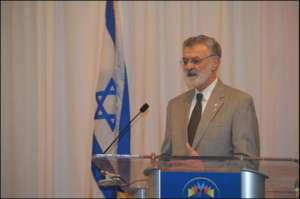
The Honorable Mayor Frank G. Jackson speaking during the 2019 Inaugural Sister Cities Conference as he welcomed Beit-She’an as Cleveland’s newest sister city - Image from CJN Photos/Ed Carroll
Beit-She’an, a beautiful city in Northern Israel, is the newest sister city of Cleveland, Ohio. On Day Two of the 2019 Inaugural Sister Cities Conference (May 2nd), Beit-She’an was named as the 23rd sister city of Cleveland and as the second of those in Israel (the first being Holon, which was made a sister city in 1977). The event was attended by representatives of the Jewish Federation of Cleveland*, J. David Heller (president and CEO of NRP Enterprises), the Honorable Mayor Frank G. Jackson of Cleveland, the Honorable Mayor Eddy Kraus of Solon, the Honorable Judge Daniel Polster (a Judge for the Northern District of Ohio), the Honorable Kevin Kelly (the President of the Cleveland City Council), the Honorable Dani Dayan (the deputy Consul General of Israel in New York), and a significant number of community members. Unfortunately, the Israeli mayors involved were unable to attend but they recorded a video message to be shown at the event. By looking at those attending, one can see that this was a highly anticipated event.[1] However, while it may only now be official, Beit-She’an and Cleveland, as well as Valley of Springs*, have been working together since 1996. In fact, the Jewish Federation of Cleveland has been working closely with Beit-She’an/Valley of Springs continuously for nearly 25 years!
In 1995, a group of people associated with the Jewish Federation of Cleveland visited Beit-She’an. This trip sparked a sister city relationship that has actively lasted over 20 years and has developed the cities involved as well as bettered their international reputations.[2]
At the time, the Jewish Agency for Israel* was encouraging many international cities to cooperate with Israeli cities for the purpose of development between cities. The Jewish Federation of Cleveland was then inspired by the Jewish Agency for Israel to create a sister city relationship with an Israeli city. Three locations were visited, and Beit-She’an was chosen. “We thought about which place would have an attraction for people from Cleveland. The archeological site had begun to be developed there and it had a very grand Roman amphitheater, so we thought that would be a special attraction,” stated Stephen Hoffman, the former President of the Jewish Federation of Cleveland. The Federation attendees enjoyed their time there, engaging with the people they met and the sights they saw. They were further impressed with Beit-She’an’s efficient government and thought that Cleveland could help in the development of the city. In 1996, the partnership between the Jewish Federation of Cleveland and Beit-She’an/Valley of Springs was started.
Two people were instrumental in the partnership’s success, especially early on. Arthur Naparstek and Robert Goldberg are credited with being the people who played the largest roles in the partnership’s success. Naparstek, a professor of social work and former dean of the Mandel School of Applied Social Sciences at Case Western Reserve University, used his expertise to help develop the community and housing. He promoted the cooperation of the local community members as well as the overall cooperation between Cleveland and Beit-She’an. Goldberg was very involved in the development and progress of Beit-She’an and its partnership with Cleveland. Both helped to get Beit-She’an and regional governments to work together, which allowed Valley of Springs to benefit concurrently with Beit-She’an. The sister city relationship also helped the region create better rapport with their two adjacent nations (Jordan and State of Palestine), such as when Jordanian and Israeli veterans from the Six-Day-War came together for a peaceful meal in Beit-She’an. The partnership, with the help of Goldberg and Naparstek, was able to encourage regional cooperation not only within Israel but also between Valley of Springs/Beit-She’an and Jordan and State of Palestine.
Within the long existence of the relationship, many initiatives have been formed. For instance, the Jewish Federation founded a choir group to accompany the Cleveland HaZamir and the two have worked together extensively. Projects like the HaZamir choir group helped create a cultural connection between Beit-She’an and Cleveland, which has provided great learning experiences to people from both cities. Moreover, modern initiatives, while they may be focused on helping Beit-She’an, are also helping Cleveland. One great example of this is the “Volunteer Beit-She’an” program, which allows for Clevelanders who are 50 or older to volunteer in Beit-She’an. Not only does this help Beit-She’an, but it also provides unique experiences to many Clevelanders.[3] Another example (one that has been in the news recently) is the Jewish Federation’s investment in STEM education opportunities in Israel with an emphasis on Beit-She’an.[4] And even then, Beit-She’an has helped develop Cleveland. A very memorable example of this was when the CEO of the Cleveland Public Library was inspired by Beit-She’an’s unique and community-building library. In the library, the children run the programs of the library, allowing for them to create clubs and activities that they know will interest the community. The CEO then planned to make Cleveland’s own Public Library have a similar system.[5] The sister city relationship has provided empowerment and development to Beit-She’an, Valley of Springs, and Cleveland as well as unique travel experiences for Clevelanders.
What makes Clevelanders’ travels to Beit-She’an and Valley of Springs so special is not only how amazing the country is, but also the many similarities between Cleveland and Beit-She’an. Joe Cimperman (the President of Global Cleveland), who called his trip there “life changing,” was reminded of Cleveland’s West Side Market when he visited markets in Israel.[6] Both Cleveland and Beit-She’an are lead with strong civil leadership (itself as a result of the sister city relationship) and most Clevelanders who visit Beit-She’an note that the cities have “a million similarities,[7]” especially with the friendliness of the people from both cities. Furthermore, the two cities have similar histories full of triumphs and downfalls and a similarly large amount of diversity. For these reasons, it is likely that any of the over 500 Northeast Ohioans who visit Beit-She’an/Valley of Springs annually could tell you that the two cities were made to be partnered.
Now, with the official ceremony of the sister city relationship between Cleveland and Beit-She’an/Valley of Springs, one cannot imagine what wonders lie ahead. From possible library innovation to continued civic cooperation, it seems nothing is beyond reach. Cleveland benefits from the relationship, Beit-She’an benefits from the relationship, Valley of Springs benefits from the relationship, and the citizens of the areas benefit from the relationship. Truly, the Beit-She’an/Valley of Springs-Cleveland sister city relationship has been one of Cleveland’s most successful and influential partnerships.
Ezra's blog - One Page Stories
*Glossary of Terms
Beit-She’an - A city in northern Israel
Valley of Springs - The Regional District that surrounds Beit-She’an, but does not include the city
The Jewish Federation of Cleveland - A group that is, according to them: “the only organization in Cleveland that focuses on the health and vitality of the entire Jewish community[8]”
Jewish Agency for Israel - An international organization that has been vital in the success of the global Jewish community and that has “been securing a vibrant Jewish future for generations to come” since 1929[9]
[1] http://www.jewishcleveland.org/news/blog/sister_city_celebration_takes_place_at_cleveland_public_library_louis_stokes_wing/
[2] https://www.clevelandjewishnews.com/news/local_news/jewish-federation-of-cleveland-sister-city-beit-shean-celebrate-/article_942d960c-f113-11e5-821a-0705cb853636.html
[3] http://www.jewishcleveland.org/news/blog/volunteer_in_beit_shean/
[4] https://www.clevelandjewishnews.com/news/local_news/supporting-israel-s-economic-growth-through-stem/article_73cea6f2-d950-11e9-a402-3bb28233b230.html
[5] https://www.clevelandjewishnews.com/news/local_news/beit-shean-library-inspires-change-at-cleveland-public-library/article_cace9910-2336-11e9-8fb2-27747237ce98.html
[6] https://globalcleveland.org/theres-much-land-can-learn-holy-land/
[7] Quote from Joe Cimperman; http://www.jewishcleveland.org/news/blog/travel_blog_civic_leaders_israel_mission/
[8] http://www.jewishcleveland.org/who-we-are/about-us/
[9] https://www.jewishagency.org/who-we-are/
Blessed are the Candle Bearers
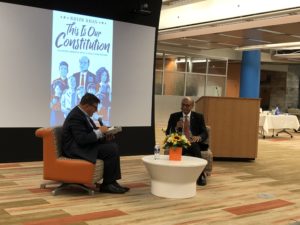 .
.
Everyone has ‘linguistic markers’. Sometimes they mark where you are from geographically, like ‘Baah Haaaabah” for Bostonians. Sometimes they mark what religion you are, like saying ‘mashallah’. Sometimes it’s just your signature word, like Ray Bradbury’s ‘cinnamon’.
Mr. Khizr Khan has three linguistic markers I picked up on during the two days I spent with him at talks in venues around Cleveland: ‘blessed’, ‘uplift’, ‘and candle bearer’. I don’t know what words Mr. Khan uses most often in everyday conversation, but his message featured these at much higher rates than any others.
It’s not surprising that ‘candle bearer’ is a signature phrase, given that he glows with the inner peace of a man doing his God-given work. But it is a challenging and inspiring phrase. Mr. Khan describes the path as dark, and the candle bearers must walk front and center to lead the way. Mr. Khan challenged every single person to harness their light and use their platform for change, be it waking up early to vote, taking someone who cannot drive to the polling station, standing up and saying one person, one vote does matter. Whatever your platform, use it. Mr. Khan reminded us that history shows us one person’s voice can change the world. “Give me liberty or give me death” is a political reality that many around the world contend with, but we in America are not forced to consider it when we send a tweet or state our opinion. Mr. Khan, however, has lived through it, and that is why he is so passionate about our United States’ Constitution.
Mr. Khan recounted how he first fell in love with the US Constitution--yes, in love. That is how deeply Mr. Khan values the words that form this idea of a More Perfect Union. It was during a comparative law class that put constitutions from around the world side by side and compared the merits or each. Nothing compared, in his mind, to the 4,543 words that make up this ‘blessed document’. The fire that was lit inside him eventually took him to America to get not one, but two LL.M. degrees from the University of Missouri Law School and Harvard Law School. It gave him a career in and a passion for law that he spreads as a doctrine of freedom and justice. And like many newcomers to the United States, Mr. Khan is deeply patriotic and grateful to this country. He spoke passionately about the 1st and 14th amendments in each talk he gave.
Pop quiz: how many rights are enshrined in the 1st amendment? How are Plessy v. Ferguson and Brown v. Board related?
You probably cannot answer those questions unless you are in 10th grade civics. And that is just Mr. Khan’s point. We take our freedom of speech for granted. We take for granted the fact that inhumane court decisions can be overturned when our mistakes have been made clear.
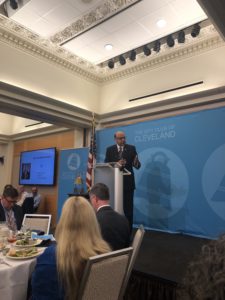
Mr. Khan spoke with the passion of Martin Luther King Jr., but at the level of Mother Teresa. He cried on stage, pausing to ask the crowd forgiveness for losing his composure. He openly acknowledged that each speech he gives tears open the wound left by the death of his middle child, Captain Humayun Khan, who was inspired by the service of President Thomas Jefferson to enroll in the ROTC program at the University of Virginia. Mr. Khan notes that he lives at the bottom of the mountain where Monticello sits, and that it was a total coincidence that he should live in the shadow of the Founding Father’s home and legacy, and that to his home are delivered bags full of letters, some only addressed “Mr. Khizr Khan, United States of America.” This man single-handedly made the United States Constitution the the best selling book in the world on Amazon, which runs out of it regularly since Mr. Khan took to the speaker circuit 3 years ago. This is also a man who was warned to stay inside during the protests in Charlottesville where, as Mr. Khan said, “our daughter, Heather Heyer, was killed”, but he saw firsthand the heavily-armed protesters and heard their ugly chants. People like this man were the aim of their ire, and yet he continues to speak. He continues to bear the light. He continues to uplift the best in us and to defend that which allows the best in us to thrive-- the rule of law, checks and balances, an independent judiciary, and a government by the people, for the people.
I could share many more stories of Mr. Khan’s, but I encourage you to see him when he visits you, or invite him to do so yourself. I will leave you with a story Mr. Khan’s grandfather in Pakistan would share with him after the sun had set, the dinner was eaten, dishes washed, homework completed, and the stars shone in the sky: A thirsty man is blocked from the river by a high wall, so high the man cannot climb it. The man, desperate in his thirst, throws a rock from the wall over it and into the river. The sound of the rock in the water fills the man with joy and hope. The man forgetting his thirst continues to throw rocks into the water. The water asks the man, ‘Why do you throw stones into the water you cannot drink?” The man replies, “Because the beautiful sound of its splashing fills all living things with joy, it is like the sound of the guard’s keys to a prisoner, the sound of rain in the desert, and every stone I throw makes the wall a little lower.” Mr. Khan encouraged us all to be like that man: joyous in our struggle, passionate in the pursuit of our goals, and hungry for the sweet drink of redemption.
“I have seen the sunrise on the other side of the mountain and it is just moments away.”
I would take Mr. Khan at his word. The night is darkest before the dawn, but that is why we are candle bearers.
